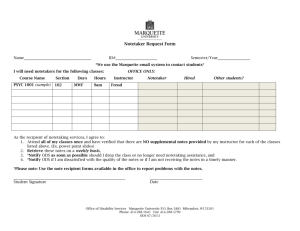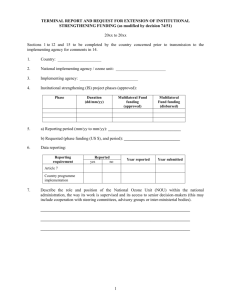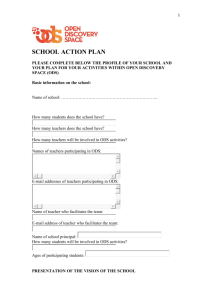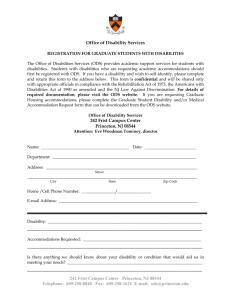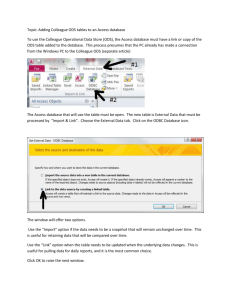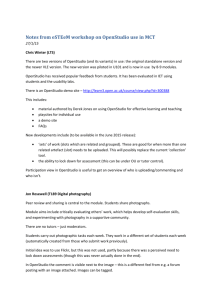Compliance Checklist- UBCO Visit
advertisement
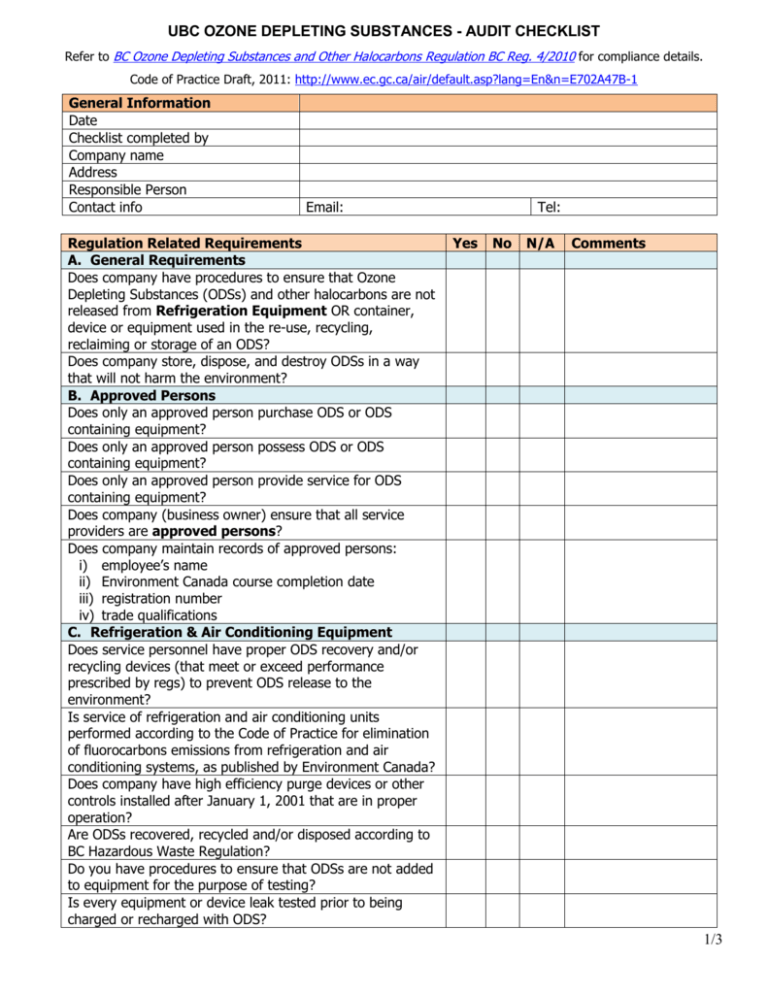
UBC OZONE DEPLETING SUBSTANCES - AUDIT CHECKLIST Refer to BC Ozone Depleting Substances and Other Halocarbons Regulation BC Reg. 4/2010 for compliance details. Code of Practice Draft, 2011: http://www.ec.gc.ca/air/default.asp?lang=En&n=E702A47B-1 General Information Date Checklist completed by Company name Address Responsible Person Contact info Email: Regulation Related Requirements A. General Requirements Does company have procedures to ensure that Ozone Depleting Substances (ODSs) and other halocarbons are not released from Refrigeration Equipment OR container, device or equipment used in the re-use, recycling, reclaiming or storage of an ODS? Does company store, dispose, and destroy ODSs in a way that will not harm the environment? B. Approved Persons Does only an approved person purchase ODS or ODS containing equipment? Does only an approved person possess ODS or ODS containing equipment? Does only an approved person provide service for ODS containing equipment? Does company (business owner) ensure that all service providers are approved persons? Does company maintain records of approved persons: i) employee’s name ii) Environment Canada course completion date iii) registration number iv) trade qualifications C. Refrigeration & Air Conditioning Equipment Does service personnel have proper ODS recovery and/or recycling devices (that meet or exceed performance prescribed by regs) to prevent ODS release to the environment? Is service of refrigeration and air conditioning units performed according to the Code of Practice for elimination of fluorocarbons emissions from refrigeration and air conditioning systems, as published by Environment Canada? Does company have high efficiency purge devices or other controls installed after January 1, 2001 that are in proper operation? Are ODSs recovered, recycled and/or disposed according to BC Hazardous Waste Regulation? Do you have procedures to ensure that ODSs are not added to equipment for the purpose of testing? Is every equipment or device leak tested prior to being charged or recharged with ODS? Tel: Yes No N/A Comments 1/3 Regulation Related Requirements Are all ODS storage containers refillable and appropriate? Are all refillable containers regularly spot-checked for leaks? Can all refillable containers be recharged with other nonODS? D. Labeling and record keeping Does all the equipment have permanently affixed, legible labels or tags stating the quantity and type of substances contained in the equipment? Are records of ODS evacuation, charge or recharge permanently affixed, on legible labels or tags AND written in a service log including: i) Result of leak test ii) Type, amount of ODS added or evacuated iii) If all ODS was evacuated it is ensured equipment does not contain ODS iv) The date the substance was added/evacuated v) Name of person performing the job, their registration number, and business name if not UBC employee Do service logs include chronological record of past 36 months for: i) Equipment service (charge/recharge of ODS) ii) Incidents iii) Leaks detected E. Use of Class I Substances Do you ensure Class I substances are NOT used for cleaning or as a diluent for a sterilant? Do you ensure Class I substances are NOT used for charging: i) refrigeration systems with a capacity of 22 KW or more Yes No N/A Comments Note: This does not apply to chillers; household refrigerators and freezers; water coolers Do you ensure chillers are not recharged with Class I substances after overhaul that includes modification or replacement of: i) Internal sealing ii) Oil heather iii) Oil pump iv) Float or vane assembly Are plans are in place to stop the use of Class I substances for chillers by January 1, 2015? F. Release Reporting Did facility have any ODS releases or spills? If yes, the following releases have been reported per Spill Reporting Regulation i) Any ODS or ODS mixture in excess of 10 kg ii) Carbon tetrachloride and dibromodifluoromethane in excess of 1 kg iii) Trichloroethane in excess of 5 kg Notes: 2/3 Schedule A Class I: CFC, Halon and Chlorocarbon Compounds 1 CFCs (chlorofluorocarbons) (a) current commercially used CFCs CFC-11, trichlorofluoromethane, R-11 CFC-12, dichlorodifluoromethane, R-12 CFC-13, chlorotrifluoromethane, R-13 CFC-111, pentachlorofluoroethane, R-111 CFC-112, tetrachlorodifluoroethane, R-112 CFC-113, trichlorotrifluoroethane, R-113 CFC-114, dichlorotetrafluoroethane, R-114 CFC-115, chloropentafluoroethane, R-115 (b) all other CFCs, and (c) all isomers and mixtures containing any of the above. 2 Halons (a) Halon-1211, also known as bromochlorodifluoromethane, Halon-1301, also known as bromotrifluoromethane, Halon-2402, also known as dibromotetrafluoroethane, (b) all other bromofluorocarbons and bromochlorofluorocarbons, and (c) all isomers and mixtures containing any of the above. 3 Chlorocarbons (a) trichloroethane also known as methylchloroform, R-140 tetrachloromethane also known as carbon tetrachloride, R-10, and (b) all isomers and mixtures containing any of the above. Class II: Hydrochlorofluorocarbons 1 HCFC-21, dichlorofluoromethane, R-21 HCFC-22, chlorodifluoromethane, R-22 HCFC-31, chlorofluoromethane, R-31 HCFC-121, tetrachlorofluoroethane, R-121 HCFC-122, trichlorodifluoroethane, R-122 HCFC-123, dichlorotrifluoroethane, R-123 HCFC-124, chlorotetrafluoroethane, R-124 HCFC-131, trichlorofluoroethane, R-131 HCFC-132, dichlorodifluoroethane, R-132 HCFC-133, chlorotrifluoroethane, R-133 HCFC-141, dichlorofluoroethane, R-141 HCFC-142, chlorodifluoroethane, R-142 HCFC-151, chlorofluoroethane, R-151 HCFC-221, hexachlorofluoropropane, R-221 HCFC-222, pentachlorodifluoropropane, R-222 HCFC-223, tetrachlorotrifluoropropane, R-223 HCFC-224, trichlorotetrafluoropropane, R-224 HCFC-225, dichloropentafluoropropane, R-225 HCFC-226, chlorohexafluoropropane, R-226 HCFC-231, pentachlorofluoropropane, R-231 HCFC-232, tetrachlorodifluoropropane, R-232 HCFC-233, trichlorotrifluoropropane, R-233 HCFC-234, dichlorotetrafluoropropane, R-234 HCFC-235, chloropentafluoropropane, R-235 HCFC-241, tetrachlorofluoropropane, R-241 HCFC-242, trichlorodifluoropropane, R-242 HCFC-243, dichlorotrifluoropropane, R-243 HCFC-244, chlorotetrafluoropropane, R-244 HCFC-251, trichlorofluoropropane, R-251 HCFC-252, dichlorodifluoropropane, R-252 HCFC-253, chlorotrifluoropropane, R-253 HCFC-261, dichlorofluoropropane, R-261 HCFC-262, chlorodifluoropropane, R-262 HCFC-271, chlorofluoropropane, R-271. 2 All other hydrochlorofluorocarbons not specifically listed. 3 All mixtures containing any of the above. Class III: Other Halocarbons 1 Hydrofluorocarbons HFC-23, trifluoromethane, R-23 HFC-32, difluoromethane, R-32 HFC-125, pentafluoroethane, R-125 HFC-134, tetrafluoroethane, R-134 HFC-143, trifluoroethane, R-143 HFC-152, difluoroethane, R-152 HFC-161, monofluoroethane, R-161 HFC-281, fluoropropane, R-281 HFC-272, difluoropropane, R-272 HFC-263, trifluoropropane, R-263 HFC-254, tetrafluoropropane, R-254 HFC-245, pentafluoropropane, R-245 HFC-236, hexafluoropropane, R-236 HFC-227, heptafluoropropane, R-227. 2 Perfluorocarbons FC-14, tetrafluoromethane FC-116, hexafluoroethane FC-218, octafluoropropane FC-3-1-10, decafluorobutane FC-4-1-12, dodecafluoropentane FC-5-1-14, tetradecafluorohexane. 3 All other hydrofluorocarbons and perfluorocarbons not specifically listed. 4 All mixtures containing any of the above. 3/3
